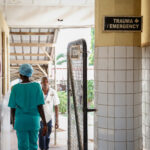- A draft of South Africa’s latest action plan on HIV and sexually transmitted infections (STIs) details big changes in how the government finds and treats gonorrhoea, chlamydia, syphilis and trichomoniasis.
- The final version of the document will be released on World Tuberculosis (TB) Day (24 March), according to a spokesperson for the South African National Aids Council.
- South Africa currently only treats people for STIs if they show up to clinics with symptoms. But most infected people won’t show any symptoms. Now, the government is planning to roll out rapid tests and home kits for people who are most at risk.
Free home tests for four common — and curable — sexually transmitted infections (STIs), namely gonorrhoea, chlamydia, syphilis and trichomoniasis, could soon be available at chronic medicine pick-up points around the country, according to a draft of South Africa’s fifth HIV, TB and STI action plan.
Government clinics will also roll out STI tests that give results on the same day.
The new plan is being finalised after comments from the public and civil society were added, says Nelson Dlamini, communications manager of the South African National Aids Council (Sanac). The final draft will be published on World TB Day on 24 March.
The updated strategy will run from 2023 to 2028.
Until now, South Africa’s public health sector hasn’t used tests as a standard to diagnose these four STIs (apart from syphilis). Instead, people get treated only if they show up to a facility with symptoms such as genital sores or discharge coming from their penis or vagina.
This is called “syndromic management” and it’s used by many low- and middle-income countries, including Tanzania and Mozambique. The logic is that many facilities don’t have easy access to a laboratory, so it might take up to 4 days for people to get their results back, and then people may not come back to the clinic to get the news or the medicine anyway.
In South Africa’s private sector, however, using lab tests to diagnose STIs is commonplace.
The trouble with the syndromic method is two-fold: firstly, most people with these STIs are asymptomatic, meaning they don’t show any symptoms (that was the case for more than three-quarters of women in one local study). So, with the current approach in the public health system, it means they won’t get treated and will continue to spread the infection to others.
What’s more, the health department doesn’t consistently collect data on how many people have one of the four common STIs (gonorrhoea, chlamydia, syphilis and trichomoniasis) on a national level. Instead, the health department and the National Institute for Communicable Diseases (NICD) run data collection drives every now and again, where samples are collected from people (who are showing symptoms) in all nine provinces and sent to the lab. The results are used to make predictions about how many of these infections are going around, and the health department then decides whether they’re buying the correct medicines.
This type of data collection makes it hard to know whether the country reached the government’s previous HIV and STI plan’s (2017–2022) goal to find 50% more symptomless cases of these four infections by the end of 2022, says Yogan Pillay, who heads the Clinton Health Access Initiative’s local arm.
When gonorrhoea, syphilis or chlamydia aren’t treated, they can cause infertility, up the chance of someone contracting HIV or, in the case of pregnant women, lead to stillbirth. People with HIV who aren’t on antiretroviral treatment can also spread this virus easier when they have gonorrhoea.
The second problem is that people who do have symptoms (and who actually show up to a clinic for help) will get an antibiotic that works against more than one infection, because health workers don’t know exactly what they’re treating. This could result in some bugs becoming resistant to those medicines, something South Africa already struggles with.
In short: the public health system is potentially over-treating people with symptoms and under-treating those without, explains Johan Hugo, a senior clinical advisor at the Anova Health Institute.
But the way South Africa approaches both these problems — through diagnostics and data — is changing. Here’s how.
Diagnostics — finding the patients
Testing people, for instance pregnant women, when they come to clinics could make a big difference, shows research published in the journal Infectious Diseases in Obstetrics and Gynaecology in 2018.
At three clinics in Tshwane, pregnant women used rapid tests for gonorrhoea, chlamydia and trichomoniasis. Nine out of 10 of those who tested positive for any of these infections could start treatment immediately, without them having to wait longer for help than they would have been in the queue anyway.
However, these tests are not widely available in South Africa’s public sector. State facilities have rapid tests for syphilis, which are commonly given to pregnant women and survivors of sexual violence, but are not available as a standard or for the three other STIs.
Under the new STI plan, though, tests would be available to many more people, including all teenage girls and young women (those between 15 and 24 years old), sex workers, transgender people, men who have sex with men and survivors of gender-based violence.
In the private sector, rapid self-test kits for single STIs cost between R125 and R200 or R500 for a kit that will screen for all four curable STIs.
Another option for the state could be to use the GeneXpert machines, already available for testing for TB, to pick up if someone has a chlamydia and gonorrhoea infection, says Hugo.
With this machine, test results are available within 90 minutes when using the chlamydia and gonorrhoea cartridges. All health workers would have to do is to replace the TB or HIV test kit inside the machine with one that works for a specific STI.
When researchers tested this method in 12 clinics in Australia, it worked just as well as laboratory tests research shows — and it’s much faster.
A study from Durban that used the GeneXpert machine to test for STIs gave similar results, and women who tested positive got medication and a pack of information, condoms and treatment for their sexual partners as soon as the results were out. The patients told researchers that this method worked for them because they got results quickly (within about two hours) and because they could help their partners.
The cartridges are pricey, though — it could cost about R250 a shot to test for gonorrhoea. So, although the Durban study showed that this method could be good for diagnosing STIs fast, it didn’t look at whether it would be an affordable option for South Africa.
But if people can get their STI results so fast in clinics, why would the government also roll out home tests?
It’s a way to get around stigma, the action plan says. Discrimination at clinics makes it hard for people to get the health services they need — especially for people who are at a high risk to contract STIs, such as sex workers and transgender people.
Close to 40% of the practitioners involved in one study felt uncomfortable caring for patients who come from such high-risk groups, also called key populations.
In a Brazilian study, transgender women said they were far more comfortable collecting their own samples (from their anus, urethra or mouth) than having a health worker do it.
Pillay cautions, though, that sending out self-test kits could create another set of problems when it comes to keeping track of infections.
Health workers wouldn’t know whether people used the test, he says, and if they have, there’s no guarantee they would come in for treatment.
Data — Getting the numbers
There were over 4.5-million estimated new cases of gonorrhoea in South Africa in 2017, as well as 5.8-million new chlamydia infections and 70 000 cases of syphilis, according to a 2018 modelling study.
But these figures are only educated guesses and could be inflated, the researchers caution, because there wasn’t much data for them to work with. That meant they had to do “crude” calculations based on figures from a bunch of smaller studies, which didn’t all have the same research method.
Under the new HIV and STI plan, the health department says it will conduct nationally representative studies to determine how many of these STIs are going around in the people most likely to be infected (such as sex workers and young women, for example).
This kind of data will make it easier for South Africa to find and treat more people with STIs, without having to test everyone in the country, Pillay says.
In the meantime, health facilities are going to change the way they collect data for people who are showing symptoms of STIs.
At the moment, health workers only record information for male urethritis syndrome. This is a condition where a bacterial infection — which is sexually transmitted — causes inflammation in the urethra (the tube along which urine flows out from the bladder). Close to 311 000 men showed up at healthcare facilities with symptoms of this condition in 2017.
While men are more likely than women to show symptoms of infections such as chlamydia and gonorrhoea, they’re much less likely to ask for help quickly, Pillay notes.
But in the next few months, health workers will likely start recording cases of vaginal discharge syndrome in women and genital ulcer disease too, he says, because these are underlying symptoms of STIs like chlamydia and herpes among this gender.
Tracking these two syndromes can help the government to understand STI trends in women who show symptoms, so that they can pick up in which areas more intensive testing and treatment has to happen, explains Pillay.
To help make sure the people who need treatment get it, the health department also plans to add an STI section to the country’s tracking platform that helps monitor people who are on HIV and TB treatment, called Tier.Net.
This system keeps track of people who are on, for example, HIV medication so that health workers know to test their viral load (how much of the virus is in their blood) each time the patient comes for a check-up at the clinic. The online platform doubles as a way to collect data and filter it to the government to help manage the country’s response to HIV infections. In the same way it could help to also keep track of STI numbers.
But Tier.Net has had drawbacks, research shows. Health workers have battled to keep it updated alongside the paper records, which has resulted in mismatches between what’s on electronic sheets and what’s in a clinic’s books.
Until then, Pillay says, health workers should simply encourage more people to get screened for STIs while having other check-ups at a healthcare facility.
Zano Kunene is a health journalist at Bhekisisa.









